 |
|

|
 |
TABLE of CONTENTS
|
Online map provides efficient way to gather public feedback |
By Nick Carpenter, Metro District Communications and Engagement
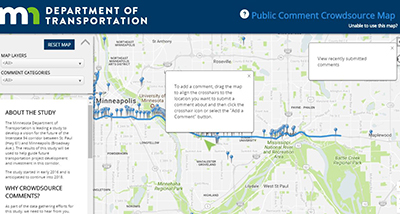
The I-94 interactive map allows the public to voice their opinions about the future of the I-94 corridor. |
A new online mapping tool is proving to be an effective resource for gathering public input about Interstate 94 through the Twin Cities.
MnDOT’s Rethinking I-94 team launched the interactive map in mid-August with the intent of reaching more people with opinions about the I-94 corridor.
“We want to know how I-94 works for those who use it and live by it, and how the interstate affects their life on a daily basis,” said Brian Isaacson, Metro District Planning, Program Management and Transit Office director. “What we learn using this map and through our other engagement efforts will help us better identify and articulate neighborhood-level transportation values, issues and concerns that will help shape and prioritize future transportation investment along I-94."
The map is one of many tactics being used to gather public feedback that is part of a larger I-94 study dubbed “Rethinking I-94.” The two-year study is aimed at developing a comprehensive, long-term and community-based approach to address I-94 study area needs between Hwy 61 in St. Paul and Broadway Avenue in Minneapolis.
To date, hundreds of comments have been added to the interactive map, which also allows users to upload photos of specific areas along I-94 that coincide with their comments.
Map users also are prompted with a short demographic survey prior to leaving a comment. This information provides the team with a better understanding of who they are hearing from and who they need to do a better job reaching based on corridor demographics.
Feedback received through the interactive map and additional engagement efforts will be used by the team to build out next steps of community engagement around transportation concepts that align with a shared vision for I-94.
For more information about the interactive map and the Rethinking I-94 study, visit mndot.gov/I-94minneapolis-stpaul. |
 |
|

|
 |
TABLE of CONTENTS
 |
Employees engage thousands during State Fair’s 12-day run |
By Dana Hernandez
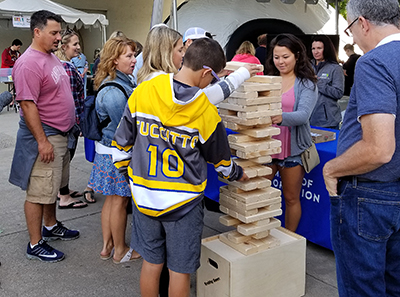
Fairgoers tried the giant jenga game at the MnDOT’s STEM booth at the State Fair. Photo by Nicole Bartelt |
2017 was a year for record breaking attendance at the Great Minnesota Get Together. MnDOT’s presence was strong this year as employees participated in STEM Day, the Eco Experience and Education buildings and the daily parade.
About 13,000 people were there to visit Dan Patch Park for STEM Day at the Fair.
“STEM Day went great,” said Nicole Bartelt, STEM education and outreach coordinator. “We estimate we were able to interact with 700-850 people at our booth.”
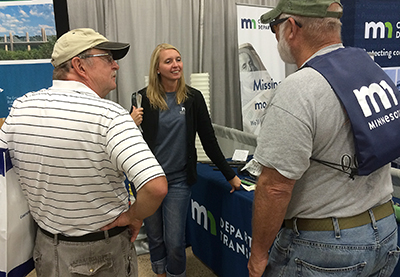
April Crockett, Metro District area manager, talks with fairgoers at MnDOT’s State Fair booth. Photo by Sue Roe |
MnDOT staff and volunteers greeted fairgoers in the Kick Gas booth. The display was part of the Eco Experience exhibit, which was filled with hands-on activities, demonstrations and resources. People learned about safe walking behaviors, car and bike sharing, transit and much more. Attendees also received their first glimpse of the 2017 Minnesota state bicycle map. Over 5,000 maps were distributed in 12 days.
In the Education Building, 88 employees volunteered to staff the MnDOT exhibit, handing out 21,200 maps to fairgoers. There were 26 first-time employees working the booth this year.
MnDOT parted with the “transportation funding” theme from the previous two years and embraced a construction zone theme this year. The display involved highlighting key technology and innovation techniques that are efficient, help to manage traffic and work to ensure safety. Topics surrounding work zone safety are important reminders for the public, notably since a number of current MnDOT projects are on high-volume roadways.
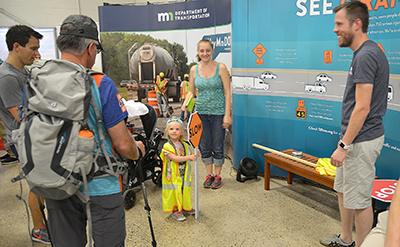
Adam Oie, Office of Communications (right) looks on as a family takes a photo of their daughter in safety vest and flagger sign at the State Fair booth. Photo by Rich Kemp |
Many took the opportunity to engage with the booth. The photo opportunity featured a construction zone backdrop, vests and flagger signs. Apart from taking pictures, MnDOT presented the finished St. Croix Crossing with hands-on bridge materials and a bridge model.
Check out 360° views of the MnDOT booth in the Education Building or the snow plow and Go Mobile from the daily parade via Facebook.
“This year’s Minnesota State Fair was an incredible event. We were able to talk with thousands of people, answer hundreds of questions and learn a great deal about what Minnesotans think about transportation,” said Kevin Gutknecht, Office of Communications director. “The weather was great, the MnDOT volunteers who worked at the display were extremely helpful and professional. We are planning and looking forward to next year.” |
 |
|

|
 |
TABLE of CONTENTS
 |
Threatened northern long-eared bats located on Twin Cities bridge |
|
By Judy Jacobs
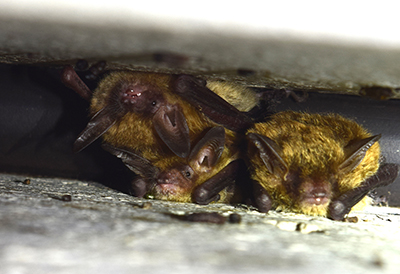
Northern long-eared bats using a Twin Cities bridge as a day-time roost. Both adults and pups were present during the bridge inspection. Photo by Christopher E. Smith |
During a recent routine, annual bridge inspection, Metro Bridge Office and Office of Environmental Stewardship employees had a rare find. They discovered federally threatened northern long-eared bats residing on a Twin Cities Metro bridge that spans the Minnesota River.
The northern long-eared bat is protected by the federal Endangered Species Act of 1973.
“There are few reports of northern long-eared bats using bridges, especially this far north,” said Andrew Horton, U.S. Fish and Wildlife Service biologist. “This discovery will help inform future guidance to transportation agencies, and contributes to our overall understanding of this species’ use of man-made structures.”
MnDOT’s effort to better understand bridge use by bats has been a partnership with the Bridge and Environmental Stewardship offices which started in 2015. Bridge inspectors document whether or not bats, or bat signs, are observed during their inspections, and MnDOT biologists conduct surveys of bridges ahead of construction projects to determine which species of bats are present. This information helps MnDOT plan construction and maintenance activities in a way that minimizes impacts to bats.
Eights species of bats reside in Minnesota. In addition to the federally threatened northern long-eared bat, three other species are listed at the state-level in Minnesota. To avoid disturbing bats (and birds) MnDOT has moved much of its tree clearing to the winter months.
Future regulations may require MnDOT to incorporate conservation measures into bridge projects to minimize impacts to bats.
“It is important that we start learning about bats and their use of bridges as habitat now,” said Christopher Smith, protected species coordinator. “This work helps demonstrate MnDOT’s commitment to good wildlife stewardship.”
For more information on bats, visit MnDOT’s bat website. |
 |
|

|
 |
TABLE of CONTENTS
 |
Mike Ginnaty chosen to serve in mobility as District 2 engineer |
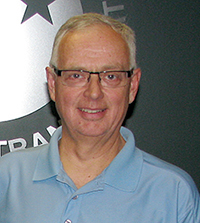
Mike Ginnaty is serving in a mobility as the District 2 engineer. Photo by Jerimiah Moerke |
Mike Ginnaty has accepted the district engineer mobility in District 2. His appointment began Sept. 6. Ginnaty will serve in that role for approximately nine months while Craig Collison focuses his efforts on the safety culture within MnDOT.
Ginnaty was the assistant district engineer in District 4 for program delivery, managing the areas of construction, design, materials and traffic.
Ginnaty graduated from the University of Minnesota in 1984 with a civil engineering degree.
He started his career at MnDOT in 1989. For the past 28 years he has been working in District 4 Detroit Lakes. He worked in design, design automation, geographical information systems, bridge maintenance, construction, pre-design, hydraulics, surveys, right of way and planning. During that time, he also worked on mobility assignments in project scoping and cost management, the Office of Project Management and Technical Support and shared services. |
 |
|

|
 |
TABLE of CONTENTS
 |
Scott Peterson selected as new assistant commissioner for policy |

Scott Peterson is the new assistant commissioner for policy. Photo by Rich Kemp |
Scott Peterson joins the executive leadership team as the assistant commissioner for policy.
Peterson’s career with Mn/DOT started in 1995 with the Office of Investment Management. His other positions have included legislative liaison, assistant to the deputy commissioner and Financial Management director.
He served as the Office of Government Affairs director since 2008.
Peterson holds a bachelor’s degree in political science from Dakota Wesleyan University in Mitchell, S.D., and a master’s degree in economics from South Dakota State University, Brookings.
He will continue to direct MnDOT’s state, federal and tribal government affairs. |
 |
|

|
 |
TABLE of CONTENTS
 |
Interns complete civil engineering program |
By Rich Kemp
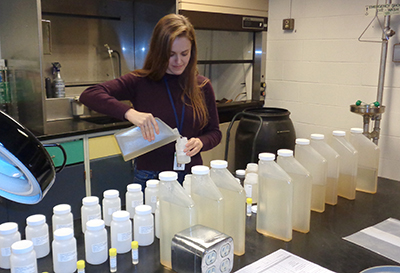
Katrina Hilton interned in the Office of Environmental Stewardship’s modeling and testing unit as part of the Civil Engineering Internship Program. Photo by Harold Bottolfson |
Ten undergraduate students completed MnDOT’s Civil Engineering Internship Program this summer. The internship is designed to provide an opportunity for undergraduate students interested in transportation-related careers to gain on-the-job experience to go along with their academic pursuits.
The interns spend 10 weeks at MnDOT gaining hands-on professional experience.
“Dedicating time to selecting, hiring and training interns has been a good investment for MnDOT,” said Nancy Daubenberger, assistant commissioner of Engineering Services Division. “We have seen benefits in the short-term by using their skills to assist us with current staffing needs, and for the future in identifying students who will work out well as permanent employees. It helps students build their network, and it expands our qualified candidate pool - it has been mutually beneficial.”
The internship program started in 2012 with four students and is offered in partnership with the Center for Transportation Studies at the University of Minnesota.
The interns worked out of 10 different offices this summer:
- Office of Project Management and Technical Support
- Office of Environmental Stewardship – Modeling and Testing Unit
- Bridge Office – Hydraulics Unit
- Office of Traffic, Safety, and Technology – Pedestrian and Bicycle Safety Unit
- Office of Traffic, Safety, and Technology – Traffic Safety Unit
- Bridge Office – Design Manual and Policy
- Metro Design
- Metro Inspection Unit
- Bridge Maintenance and Inspection Unit
- Regional Transportation Management Center
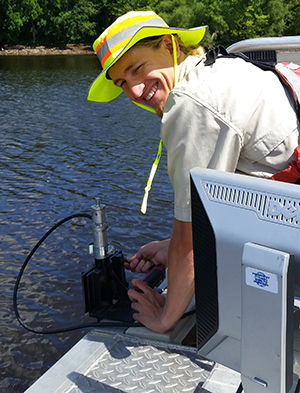
Cody Sedbrook was part of the Civil Engineering Internship Program this summer. He interned with the Bridge Office’s hydraulics unit. Photo by Solomon Woldeamlak |
The Office of Land Management had an intern in 2016 and was very impressed with her work.
“A lot of the work our office performs is done by specialized crews, which allowed our intern to jump right into production by working as part of a team and learning on the job,” said David Streitz, surveying and mapping section. “Our intern was very eager to learn, and always asking lots of relevant questions. This forces us to take a critical look at what we are doing, and in some cases, we find areas that we can improve.”
The applications are screened by CTS at the University of Minnesota and sent to Lorianna Yang, Civil Engineering Internship Program manager.
“The students rank their career interests and then we match them up with one of the participating offices,” said Yang.
“The program is really important because we have a large number of engineers that are eligible for retirement in the next couple years. The goal is to have the students complete the internship and then transition to the Seeds Student Worker Program or the Graduate Engineer Program.”
Several of the interns from the 2016 program are in the graduate engineer program this year.
“The Civil Engineering Internship showed me the various ways that a civil engineering degree could be used, and greatly helped me decide how I wanted to focus my major,” said Trenton Pray, graduate engineer. “Choices from hydraulics, soils engineering, material testing, structure and pavement design. With the CEIP, I was able to see what each area did outside of the classroom and it helped me decide how I wanted to steer my education and my career as a civil engineer.”
“The most helpful thing I learned, other than technical knowledge, was how MnDOT operates on a day-to-day basis and is structured as an organization,” said Caitlin Johnson, graduate engineer. “Getting a chance to preview how the agency works helped me more smoothly integrate into my current job as an engineer.”
The program is currently searching for offices for civil engineering interns next year. If you are interested in hosting a student next summer and have a meaningful job experience for a civil engineering intern, contact Yang by Oct. 20. The position will be 100 percent funded from the Civil Engineering Internship Program from May 16, 2018 – Aug. 17, 2018.
For information on the program, check out the civil engineering internship website or contact Yang at Lorianna.Yang@state.mn.us. |
 |
|

|
 |
TABLE of CONTENTS
 |
Construction crews to wear TZD stickers on hard hats |
By Susan Youngs, Metro TZD coordinator

Darren Trast, transportation generalist at the Maryland Avenue Truck Station in the Metro District, shows off the new Toward Zero Deaths sticker that workers can put on their hard hats. Photo by Sue Roe |
Minnesota’s Toward Zero Deaths program is known for outside the box thinking. A focus on construction workers during the fall months is definitely outside of the box. But that is exactly what will happen during the next few months as TZD stakeholders begin distributing new construction hard hat stickers.
The stickers are designed for workers to wear as they work to maintain and build Minnesota roadways. They can be worn to illustrate a commitment to the TZD goal of reducing death and serious injuries on all roadways and to reiterate the TZD commitment to keeping road workers safe.
“This is another way to keep the dialogue going about traffic safety," said Kristine Hernandez, statewide TZD program coordinator. “It’s been 14 years since the TZD program began. Even though traffic-related deaths have decreased by 40 percent, we still see unnecessary deaths nearly every day in Minnesota. They are more than just numbers; they are friends, family and co-workers.”
Each year in Minnesota, an average of seven people die in work zone crashes and 753 fatal or serious injury crashes occur.
No stranger to work zone safety, TZD and MnDOT Communications developed the work zone safety campaign, “Hang Up! Workers Lives at Stake. Orange Cones: No Phones” in 2014 to help the traveling public remember this important message.
“I love talking about this marketing campaign to our traffic safety stakeholders,” said Hernandez. “I show the billboard and point out that even though this was paid through MnDOT, you don’t see a MnDOT logo, just the TZD logo – because we care about all workers working on or alongside roadways, not just MnDOT workers.”
The message was shared on 16 billboards around the state, announced through radio spots on approximately 80 stations, and more than 40 gas stations displayed the messages on pump toppers and window clings.
This message reached out to TZD external partners and efforts continued internally when all MnDOT vehicles got TZD decals last year. With the majority of the 2017 construction season nearly over, this is only the beginning of a process where all MnDOT construction workers will be wearing the TZD hard hat sticker. MnDOT construction and other field personnel statewide will receive these free stickers through the districts’ resident engineers and the TZD regional coordinators.
Contractors and other workers will also be encouraged to wear the helmet stickers, and other avenues will be used to reach out to these stakeholders in the near future.
For more information, contact Kristine Hernandez, Statewide TZD Program coordinator, Kristine.Hernandez@state.mn.us. |
 |
|

|
 |
TABLE of CONTENTS
 |
Minnesota’s Great River Road provides access to 565 miles of historical, recreational, scenic sights |
By Judy Jacobs
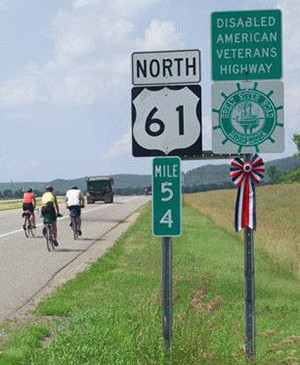
Many choices for bicycling, hiking and skiing exist along the Great River Road. Local and regional trails, Minnesota State Parks, forests, fields, cities, bluffs along the river provides a closer look at the outdoor beauty along the river. Photo courtesy of the Mississippi River Parkway Commission of Minnesota |
September is “Drive the Great River Road Month” in Minnesota, as proclaimed by Gov. Mark Dayton last week.
“The Great River Road is America’s greatest drive, encompassing 3,000 miles of interconnected roads that follow the world’s greatest river, the mighty Mississippi through 10 states, from Lake Itasca in Minnesota to the Gulf of Mexico; and The Great River Road has been designated a National Scenic Byway for its historical, cultural, recreational, natural, and scenic treasures,” notes the governor’s proclamation.
“By following the Great River Road, you not only get to some of the state’s pristine out-of-the-way places, you gain a perspective on Minnesota’s role in the development of the nation,” said Scott Bradley, assistant director, Office of Environmental Stewardship.
“September is one of the best times to explore the 565 miles of Minnesota’s stretch of the Great River Road that features three tribes, 20 counties, 43 communities and 10 interpretive centers,” said Bradley.
“Whatever drives your passion for the river, the Great River Road can help you find it,” said Carol Zoff, Great River Road program manager. “Whether it’s birding, boating, biking, history, photography…the Great River Road offers it and so much more.”
For more information on the Great River Road visit www.mnmississippiriver.com.
|
Take a virtual tour of Minnesota’s Great River Road from Lake Itasca to La Crescent by clicking on this video. Video courtesy of the Mississippi River Parkway Commission of Minnesota
|
|
 |
|

|
 |
TABLE of CONTENTS
 |
New St. Croix Crossing becomes home to federally endangered Higgins eye pearlymussels |
By Judy Jacobs

Yearling Higgins eye pearlymussels typically range in size from 2mm – 8mm. Photo courtesy of Genoa National Fish Hatchery |
Motorists traveling over the newly opened St. Croix Crossing on Aug. 29 were probably not aware that U.S. Fish and Wildlife Service mussel biologists were releasing 300 federally endangered Higgins eye pearlymussels in the river below them.
“As part of the St. Croix Bridge project’s environmental mitigation package, MnDOT provided funding to USFWS to rear federally endangered Higgins eye pearlymussels,” said Todd Clarkowski, St. Croix Crossing project coordinator. “The intent was to compensate for any mussel-related impacts caused by construction. USFWS mussel biologists released 300 Higgins eye in an area of appropriate sandy habitat by the new bridge, created specifically for them during the project’s removal of Xcel Energy’s mooring cells.”
In spring 2014, representatives from USFWS’ Genoa National Fish Hatchery, under contract by MnDOT, collected eight gravid (young-bearing) female Higgins eye from the St. Croix River at Hudson, Wis. Following collection, the USFWS team’s goal was to propagate new Higgins eye pearlymussels at the Genoa hatchery ponds to be returned to the river after construction of the new bridge was completed. Yet, facilitating mussel reproduction in the lab is no easy feat. Fertilized mussel eggs are brooded inside the females’ gills. Partway through development the larvae are released into the open water and must attach to host fish in order to complete metamorphosis into juvenile mussels. The role of the host fish adds a degree of complexity to mussel rearing that doesn’t exist for many other groups of Minnesota wildlife.
“In October 2014, the USFWS team collected juvenile mussels from 15 culturing cages that had been placed inside the Genoa hatchery pond,” said Beth Brown, environmental program specialist, Office of Environmental Stewardship. “In total, over 6,000 juvenile Higgins eye were collected. These juveniles were then cultured through two growing seasons to reach a size appropriate for release into the wild.”
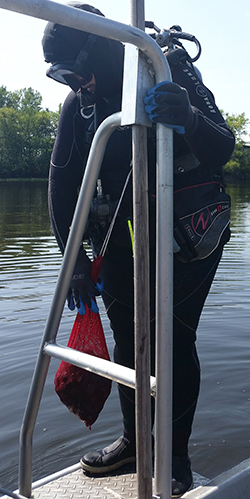
Megan Bradley, a mussels biologist with Genoa National Fish Hatchery, is preparing to release Higgins eyes pearlymussels downstream of the St. Croix Crossing. Photo by Beth Brown |
Propagation efforts for the Higgins eye pearlymussel in 2015 were not as successful as they had been the year before, with only 115 mussels produced from six newly collected females.
“This showed how variable the results of mussel culturing can be from year-to-year, and the importance multiple years of propagation,” said Brown.
2016 served as the final year for the propagation process and efforts involved a minor collection undertaking, and culturing the juveniles produced from each of the three years in two special tank systems.
“Mussel survival and growth were very good over the duration of the project,” said Clarkowski. “The individuals produced in 2014 alone were more than enough to accomplish the St. Croix Crossing Project’s environmental commitment.”
Prior to the recent placement of the Higgins eye in the St. Croix River, a final inventory was taken at the Genoa hatchery. At that point the count reflected over 3,000 sub-adult mussels, a significanly greater number than originally targeted.
In an effort to further promote the recovery of the endangered species, the surplus mussels will be used to begin new Higgins eye populations in other suitable rivers.
“This project has been successful far beyond our original goal,” said Brown. “It’s exciting that this team was able to protect local populations of these native mussels on the St. Croix River, as well as enhance their presence elsewhere in the region to improve the species’ chance of recovery.” |
 |
|

|
 |
TABLE of CONTENTS
 |
Rail crossing safety begins with you |
By Charlie Zelle, Commissioner
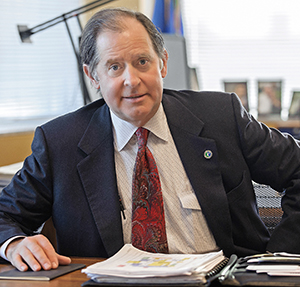
Commissioner Charlie Zelle. Photo by David Gonzalez |
There’s good news and bad news about what’s happening with rail crossing safety in Minnesota.
The good news is that vehicle-train crashes at highway-rail grade level crossings declined over the past 10 years.
The bad news is that these incidents are far more likely to result in death or serious injury than other types of highway crashes.
Last year in Minnesota, six people died and 19 people were injured at highway-rail crossings. More than just statistics, these people are family members, friends, co-workers and neighbors whose lives were needlessly cut short and changed forever in one brief moment. The majority of these crashes were at crossings with active warning devices such as gates, bells and flashing lights.
Unfortunately, already there have been 15 crashes in the first five months of 2017. Thankfully, there were no fatalities at public crossings, although five injuries were reported.
These are preventable tragedies. This year, MnDOT is spending nearly $10 million to either update existing equipment or install new gates, flashing lights and circuitry on 36 crossings. Our partner, Minnesota Operation Lifesaver, spends countless hours raising public awareness about rail safety. This is a powerful partnership to address a serious problem, but we must now reach out to another critical partner: you.
The top three contributing factors to crashes involve motorists:
- Failing to yield right of way
- Disregarding traffic control devices
- Turning improperly
A train traveling 55 miles per hour takes a mile or more to stop. The force of a train hitting a car equals the force of a car crushing a can. These are sobering facts when you consider the human lives that are at stake.
September is Rail Safety Month in Minnesota and Minnesota Operation Lifesaver is coordinating events across the state to raise awareness and educate the public on how to drive and walk safely around rail crossings.
To eliminate needless rail-related deaths and injuries, we need your help. We all need to choose to obey all traffic control devices, including treating flashing signals as stop signs. We need to put safety first by not racing a train to the crossing, waiting patiently at the tracks until the train passes and never trespassing by walking on or near rail tracks.
If you have children or grandchildren, it’s time to model appropriate safety behavior and talk to them about ways to stay safe around rail crossings.
Talk to them about distracted driving and walking, too, which we all know plays a heavy role these days in all types of crashes.
Together, through awareness and a commitment to making safe choices, we can reduce these tragic rail-related deaths and injuries in Minnesota to zero. |
 |
|

|
 |
TABLE of CONTENTS
 |
Vacation donation program: An extraordinary benefit |
By Rosemarie Merrigan, Office of Equity and Diversity

Rosemarie Merrigan, Office of Equity and Diversity, participated in the Vacation Donation Program in 2017. Photo by David Gonzalez |
About a year ago, I was diagnosed with pancreatic cancer. The news was as devastating as it was unexpected. I didn’t feel sick, not yet. But major surgery and chemotherapy took care of that soon enough.
I went on medical leave in November 2016. I was fortunate that I had nearly four months of sick and vacation time banked, having accrued those hours during the 12-plus years I’ve worked for MnDOT. Even so, by March 2017 my leave balance was down to zero and I was facing the prospect of no paychecks coming in.
I had heard of the state’s vacation donation program, designed to help critically ill state employees who have used up all their sick and vacation time due to illness. The program had benefited my friend and co-worker, Bruce Lattu, several years before. But I wrestled with applying for it for myself, unsure how public I wanted to make my health struggle. Necessity decided for me, however, and I soon enrolled in the program.
I am overwhelmed by the generosity of MnDOT employees, whose names I don’t even know, who donated vacation hours to my leave bank. It’s been a life saver. The vacation donation program has allowed me to receive a paycheck and provide for my daughter and myself when I otherwise would have been unable to do so. And it’s helped to supplement my paycheck now as I ease back to work part-time.
The vacation donation program is an extraordinary benefit, and I am so appreciative of the people who were willing to contribute their valuable vacation hours to help me and other seriously ill state employees. It’s made a difference in my and my daughter’s lives, and for that, we are forever grateful. Thank you.
Editor’s note: Employees may donate up to 40 hours of vacation per fiscal year to one or more eligible recipients. To donate vacation hours, go to the Employee Self Service Web site and click “Other Payroll” and then “Leave Donations.” The site lists all state employees eligible for the program. John (Roy) Forsberg, a 25-year employee in the District 2/Bemidji Construction Office, is the only MnDOT employee currently eligible. For more information about the program, see your HR benefits person. |
 |
|
| |
|



